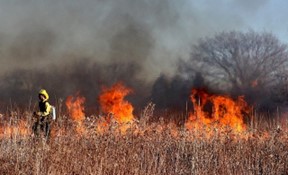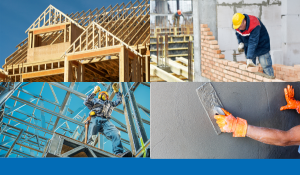California continues to battle devastating wildfires that are leaving an unprecedented trail of...
Protect Your Business From Wildfires
Wildfires are a force of nature that can ruin the lives, land, and structures that stand in their path. Securing your business and residential or commercial property from wildfires is more important than ever, as wildfire season becomes longer and creates bigger fires-- leading to more properties and acres burned each year. According to the National Interagency Coordination Center, 60% of the biggest wildfire seasons (based on overall acres burned) have taken place in the last 10 years.
Federal wildfire suppression expenses in the United States average 1.6 billion dollars each year, however, this just accounts for a fraction of the overall costs of wildfires when considering the lives lost, structures destroyed, and acres burned. Proactive risk management methods can help keep the costs of wildfires down, along with keeping your organization and your neighborhood safer in the face of such disasters.
This post provides an introduction to the risks wildfires pose, as well as actions that organizations like yours can take to mitigate those dangers.
The Dangers of Wildfires
Humans trigger almost 85% of wildfires in the United States. These fires usually result from ignored campfires, the burning of particles, devices used and malfunctions, poorly discarded cigarettes, and deliberate acts of arson. When a wildfire flares up, it can cause fast destruction. Wildfire direct exposures consist of:
- Direct flames— Actual flames that come in contact with structures or combustible products can spark these structures or materials on fire.
- Airborne embers— Embers can arise from the burning wildfire itself, along with from any flammable products previously ignited, such as close-by plants. These embers-- consisting of wind-blown embers, in particular-- are the leading cause of structure ignitions.
- Radiant heat— If radiant heat is high enough and lasts long enough, it can set combustible items on fire, such as wood siding. If direct flames come into contact, it can also make materials easier to fire up.
Wildfires can trigger direct property damage to organizations-- leading to service interruptions, transport blockages, and utility disturbances. Costly and lengthy recovery concerns from a wildfire might force services to pass on the expenses to their consumers by raising rates. Otherwise, affected services may have to close their doors entirely.

Mitigating Wildfire Exposures
Given that wildfires are so harmful, companies should be proactive to assist in decreasing the potential effects. A wildfire risk management strategy can significantly minimize the likelihood of property damage, minimize expensive service disturbances, and-- consequently-- prevent an economically draining healing process.
The first step that your service must take in developing a wildfire risk management method is to evaluate the vulnerabilities of your business property. Considering that wildfires depend on heat and embers coming into contact with various fuel sources to spread, of the most effective ways to prevent a wildfire from spreading is to reduce fuel loads. Roof, exterior walls, windows, vents, seamless gutters, decks, and other accessories are all at risk of igniting, so selecting fireproof or noncombustible materials-- like brick and concrete-- can decrease that risk. Strategic positioning and selection of trees, bushes, and other landscaping aspects can likewise reduce the risk of wildfire damage.
Here are methods by which your business can slow the spread of wildfires, successfully lessening the risks of damage:
- Create a buffer zone. Developing three unique buffer zones around the structure can keep fire and embers from spreading. These zones should include the following:
- Zone 1 (30 feet from the building)— To secure the area closest to the building, eliminate all dry and dead plants and get rid of any branches hanging over the structure's roofing. When creating the landscape, be selective about which greenery is planted and think about using non-combustible products, such as gravel or rock "mulch." Flammable products, consisting of firewood, ought to not be stored in Zone 1.
- Zone 2 (30-60 feet from the building)— If a fire can be slowed in Zone 2, there's a greater chance it will not infect the structure. Fires in this zone generally spread between trees, so eliminate any dead vegetation and hanging branches. Group trees and shrubs a minimum of 30 feet apart and prune them consistently. Move storage sheds, trailers, benches, and other flammable products to Zone 3.
- Zone 3 (60 feet or more from the building)— Zone 3 is the structure's first line of defense. Removing dead plants and trees, as well as cutting and spacing out trees and shrubs, can produce firebreaks that make it tough for the wildfire to jump between trees and other vegetation. If the structure lies on a slope, Zone 3 should encompass an additional 150-200 feet, because fast-moving fires with longer flames can establish in these areas.
- Install Class A-rated roofing. Class A-rated roof uses the greatest resistance to fire. This covering includes concrete or clay roof tiles, fiberglass asphalt composition shingles, and metal roofing systems.
- Clear the clutter. Gutters and roofing ought to be cleared of particles, such as pine needles and leaves, to decrease the risk of ignition. This upkeep must occur at the change of the seasons and after any storms.
- Be cautious when storing combustible items. Wood pallets, gas tanks, flammable liquids, and other combustibles ought to be kept where they will not end up being simple fuel.
- Maintain or change vent screens. Airborne embers can get into a building through vents in the roof, walls, and underneath the structure. Secure vents with a one-eight-inch metal screen to block cinders and gear up chimney outlets with stimulate arrestors with a one-half-inch mesh screening. Inspect and get rid of built-up particles from all vent screens.
As the risk of wildfires continues to grow, organizations like yours need to have plans to prepare for, recuperate, and endure such occasions.
For more risk management guidance on your Commercial Property and Liability, call us today at 909.466.7876.




